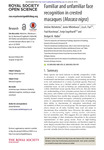Please use this identifier to cite or link to this item:
http://lib.hpu.edu.vn/handle/123456789/21771Full metadata record
| DC Field | Value | Language |
|---|---|---|
| dc.contributor.author | Micheletta, Jérôme | en_US |
| dc.date.accessioned | 2016-06-25T01:57:27Z | |
| dc.date.available | 2016-06-25T01:57:27Z | |
| dc.date.issued | 2015 | en_US |
| dc.identifier.other | HPU4160266 | en_US |
| dc.identifier.uri | https://lib.hpu.edu.vn/handle/123456789/21771 | en_US |
| dc.description.abstract | Many species use facial features to identify conspecifics, which is necessary to navigate a complex social environment. The fundamental mechanisms underlying face processing are starting to be well understood in a variety of primate species. However, most studies focus on a limited subset of species tested with unfamiliar faces. As well as limiting our understanding of how widely distributed across species these skills are, this also limits our understanding of how primates process faces of individuals they know, and whether social factors (e.g. dominance and social bonds) influence how readily they recognize others. | en_US |
| dc.format.extent | 14 p. | en_US |
| dc.format.mimetype | application/pdf | en_US |
| dc.language.iso | en | en_US |
| dc.publisher | The Royal Society | en_US |
| dc.subject | Biology | en_US |
| dc.subject | Behaviour | en_US |
| dc.subject | Cognition | en_US |
| dc.subject | Crestedmacaques | en_US |
| dc.subject | Dominance | en_US |
| dc.subject | Individual recognition | en_US |
| dc.title | Familiar and unfamiliar face recognition in crested macaques | en_US |
| dc.type | Book | en_US |
| dc.size | 973KB | en_US |
| dc.department | Education | en_US |
| Appears in Collections: | Education | |
Files in This Item:
| File | Description | Size | Format | |
|---|---|---|---|---|
| 0149_Familiarandunfamiliarfacerecognition.pdf Restricted Access | 973.8 kB | Adobe PDF |  View/Open Request a copy |
Items in DSpace are protected by copyright, with all rights reserved, unless otherwise indicated.
